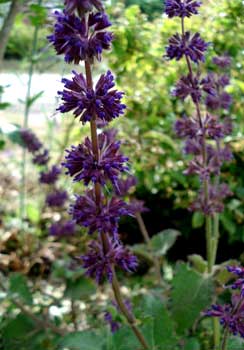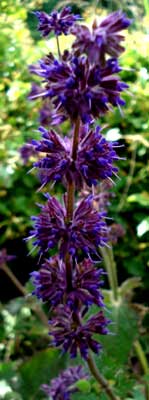
'Purple Rain'
Lilac Sage
or, Whorled Clary
"I only wanted to see you laughing in the purple rain."
-Prince
b.1958
b.1958
 An untidily mounding clump of ovate/heartshaped hirsute fragrant olive-green basal leaves are a little less floppy if grown in poor sandy soil, though growth rate is more rapid in a richer soil. It is sometimes called "cascading" foliage but I think untidy better captures it.
An untidily mounding clump of ovate/heartshaped hirsute fragrant olive-green basal leaves are a little less floppy if grown in poor sandy soil, though growth rate is more rapid in a richer soil. It is sometimes called "cascading" foliage but I think untidy better captures it.Salvia verticcillata 'Purple Rain' is more compact than the species, however, so the manner by which it heaps upon itself is by no means displeasing. From these leaves arise eighteen inch to two foot spikes of gorgeoius purple-blue blossoms.
It yellows in winter then can be clipped to the ground. It's extremely cold hardy (potentially to Zone 4, certainly to 5), so should perennialize well, but its first winter in the garden (especially on Puget Sound) it will be at risk of rotting out of the garden not because the winter is cold but because it's rainy.
It's tolerant of dampness the rest of the year, but soggy during winter dormancy just might do it in. A full-sun location in a raised bed or other sharply draining location should see it through.
Its other risk for its first year is summer/autumn burn-out. It'll bloom its heart out before putting out a sufficient root system, then be too weakened for winter survival & for a strong return the following year. So it needs moderate watering through summer, avoiding droughtiness, & let its first round of flowers dry out on the clump so that it will be less inclined to rebloom quite so ferociously.
Then its second year in the ground it'll need less water (it'll never appreciate outright drought) & can be deadheaded with some foliage sheering as well, to induce continuous reflowering all of summer & much of autumn.
It likes full afternoon sun. Though it'll bloom well in a slightly shady space, the more shade it gets the more susceptible it will be to powdery mildew, leafspot, or rust, which is also reason not to plant it alongside beebalms or other such favorites of powdery mildew. If a clump does become afflicted, clip off all the leaves, discard rather than compost; it should grow back fine especially with less overhead watering or more sun.
Like all sages, 'Purple Rain' is beloved of butterflies & bees & hummingbirds. It's superb for cut flowers, a good container-garden choice, & not a favorite of deer. It looks its best in a semi-wild cottage garden or mixed perennial border.
'Purple Rain' will not grow true from its seeds & is best propogated through division. It has a rapid growth rate & could be divided as often every other year, or as seldom as never, the clump eventually spreading to a foot & half across.
The species is known as Lilac Sage due to the color of the flower, & as Whorled Clary because the blooms arrange themselves in whorls, often but not invariably lined up in an upright row of distinct pompoms.
Though regarded as a garden ornamental rather than a culinary sage, the species does produce potent essential oils with many well-studied chemical consitituens. Lilac Sage oil is a common food ingredient in the Near East. Attempts have been made in the "underground" to find illicit uses of this salvia as a marijuana substitute, but this isn't apt to provide any recreational benefit (though Salvia divinorum, or "diviner's sage," might better fit the bill, not that I'm promising it will).